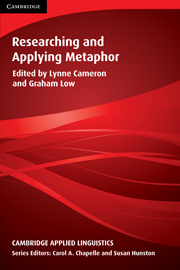Book contents
- Frontmatter
- Contents
- List of contributors
- Acknowledgements
- Conventions
- Series editors' preface
- Preface
- I KEY ISSUES IN METAPHOR RESEARCH
- II FROM THEORY TO DATA
- III ANALYSING METAPHOR IN NATURALLY OCCURRING DATA
- 7 Who framed SLA research? Problem framing and metaphoric accounts of the SLA research process
- 8 Bridges to learning: Metaphors of teaching, learning and language
- 9 Corpus-based research into metaphor
- IV ANALYSING METAPHOR IN ELICITED DATA
- References
- Index
8 - Bridges to learning: Metaphors of teaching, learning and language
Published online by Cambridge University Press: 05 October 2012
- Frontmatter
- Contents
- List of contributors
- Acknowledgements
- Conventions
- Series editors' preface
- Preface
- I KEY ISSUES IN METAPHOR RESEARCH
- II FROM THEORY TO DATA
- III ANALYSING METAPHOR IN NATURALLY OCCURRING DATA
- 7 Who framed SLA research? Problem framing and metaphoric accounts of the SLA research process
- 8 Bridges to learning: Metaphors of teaching, learning and language
- 9 Corpus-based research into metaphor
- IV ANALYSING METAPHOR IN ELICITED DATA
- References
- Index
Summary
‘A metaphor is the bridge to reality’ A classical Arabic saying
Introduction
A metaphor can easily be seen as a bridge, etymologically ‘carrying over’ from one side to another. It links and comprises the known and the unknown, the tangible and the less tangible, the familiar and the new. As “a bridge enabling passage from one world to another” (Shiff, 1979: 106), metaphors enable learners “to understand and experience one kind of thing in terms of another”, to paraphrase Lakoff and Johnson's (1980: 5) notion of the essence of metaphor. In this paper, we explore teachers' and students' metaphors of teaching, learning and language. The generation of metaphors in such professional contexts as learning how to teach, and learning about language in speech therapy and communication courses, is, we will argue in this paper, a bridge to the ‘reality’ of the professional or technical world.
Outline of the study
In this study we examine metaphors from four sources:
spontaneous metaphors arising in experienced UK primary teachers' accounts of learning;
elicited metaphors about teaching and language collected from postgraduate students on primary education courses in the UK;
elicited metaphors about language collected from undergraduates studying linguistics on speech therapy or human communication courses in a UK institution; and finally
cross-cultural elicited metaphors about ‘good teachers’ from university students in five other countries. The four sets of data overlap sufficiently to allow the metaphors to be seen as bridges to learning, albeit in different ways.
- Type
- Chapter
- Information
- Researching and Applying Metaphor , pp. 149 - 176Publisher: Cambridge University PressPrint publication year: 1999
- 85
- Cited by

